Choosing Your First Tropical Fish
Danios
 Danios are an excellent starter fish for your freshwater aquarium. This includes zebra danios, leopard danios and giant danios. Both long
fin and short fin danios are excellent starter fish. They are not particular
about a specific temperature, they are small, active and beautiful fish, very
entertaining to watch swim together in a school and very inexpensive. Danios are
perfect for smaller tanks because of their small size and minimal requirements.
Danios are an excellent starter fish for your freshwater aquarium. This includes zebra danios, leopard danios and giant danios. Both long
fin and short fin danios are excellent starter fish. They are not particular
about a specific temperature, they are small, active and beautiful fish, very
entertaining to watch swim together in a school and very inexpensive. Danios are
perfect for smaller tanks because of their small size and minimal requirements.Tetras
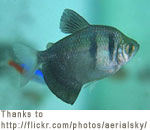 Not all species of Tetra fish are suitable for starting a freshwater aquarium. The general rule of thumb for choosing tetra fish for staring up your tropical fish aquarium is to choose Tetras with large, round shaped bodies. Thin, torpedo shaped tetra fish like neon tetras are not suitable for staring out your aquarium. Here are some of the hardier tetras: Serpae tetra, bleeding heart tetra, red eye tetra, white skirt tetra, black skirt tetra, lemon tetra.
Not all species of Tetra fish are suitable for starting a freshwater aquarium. The general rule of thumb for choosing tetra fish for staring up your tropical fish aquarium is to choose Tetras with large, round shaped bodies. Thin, torpedo shaped tetra fish like neon tetras are not suitable for staring out your aquarium. Here are some of the hardier tetras: Serpae tetra, bleeding heart tetra, red eye tetra, white skirt tetra, black skirt tetra, lemon tetra.
Barbs
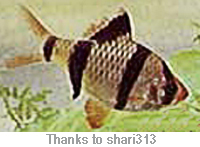 Most barbs are a good choice of tropical fish for the beginner. When choosing fish to accompany the barbs, you have to be careful about the tank mates that you put with the barbs, they are considered to be semi-aggressive and they can nip the fins of slower moving fish, like angelfish and betta fish. Some of the most common and hardy barbs are Tiger Barbs, Cherry Barbs and Rosy Barbs. If your aquarium is small, 20 gallons and under, you might not want to include barbs because of their territorial nature.
Most barbs are a good choice of tropical fish for the beginner. When choosing fish to accompany the barbs, you have to be careful about the tank mates that you put with the barbs, they are considered to be semi-aggressive and they can nip the fins of slower moving fish, like angelfish and betta fish. Some of the most common and hardy barbs are Tiger Barbs, Cherry Barbs and Rosy Barbs. If your aquarium is small, 20 gallons and under, you might not want to include barbs because of their territorial nature.
Betta Fish
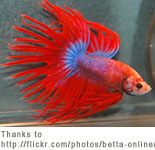 Contrary to popular belief, betta fish are a poor choice for cycling an aquarium. Betta fish are a poor choice in any aquarium because they are easy targets for fin-nipping fish and they can nip fins of other fish themselves. In the wild, betta fish prefer to be alone living in cloudy almost swamp like conditions. A large tank makes them feel uncomfortable and vulnerable. Betta fish are best left to their small well maintained aquariums and bowls.
Contrary to popular belief, betta fish are a poor choice for cycling an aquarium. Betta fish are a poor choice in any aquarium because they are easy targets for fin-nipping fish and they can nip fins of other fish themselves. In the wild, betta fish prefer to be alone living in cloudy almost swamp like conditions. A large tank makes them feel uncomfortable and vulnerable. Betta fish are best left to their small well maintained aquariums and bowls. Click on Betta Fish for more detailed information on their care
Scavengers and Bottom Feeders
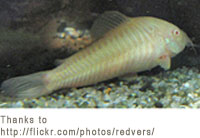 Examples of tropical bottom feeding fish include Corydoras catfish, algae eating fish such as plecostomus, Loaches, Crustaceans, Chinese Algae Eaters, Octocinclus and sharks.When setting up a new aquarium, avoid introducing bottom feeders until your tank is fully cycled and established, after about 2-4 months. Most species of catfish and algae eaters are sensitive to high ammonia and nitrite levels found in new aquariums. Also in new aquariums there is often very little for them to scavenge and no algae at all.
Examples of tropical bottom feeding fish include Corydoras catfish, algae eating fish such as plecostomus, Loaches, Crustaceans, Chinese Algae Eaters, Octocinclus and sharks.When setting up a new aquarium, avoid introducing bottom feeders until your tank is fully cycled and established, after about 2-4 months. Most species of catfish and algae eaters are sensitive to high ammonia and nitrite levels found in new aquariums. Also in new aquariums there is often very little for them to scavenge and no algae at all. Avoid introducing snails or algae eating fish because there is not enough microorganisms and algae for these types of fish to feed on and survive. Wait until your tank is more established before adding snails and algae eaters and then supplement their diet with shrimp pellets or algae wafers.
Cichlids
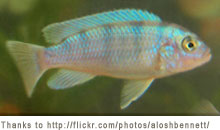 The cichlid family is a very large and diverse group of tropical fish. African cichlids from Lake Malawi, Lake Tanganyika, and Lake Victoria are excellent cichlid fish for starting a new aquarium. Be aware these fish are not community fish and are very aggressive. If you choose African cichlids for your aquarium then you must stock your tank with only cichlids!
The cichlid family is a very large and diverse group of tropical fish. African cichlids from Lake Malawi, Lake Tanganyika, and Lake Victoria are excellent cichlid fish for starting a new aquarium. Be aware these fish are not community fish and are very aggressive. If you choose African cichlids for your aquarium then you must stock your tank with only cichlids!South American cichlids such as Oscars, Jack Dempsey Chiclids, and Black Belt Cichlids get very large and are also extremely territorial and aggressive.
If you plan on keeping cichlids in general then a larger aquarium, 33 gallons and up is a must.
We highly recommend cycling your tank with Zebra Danios and large-bodied Tetra Fish.